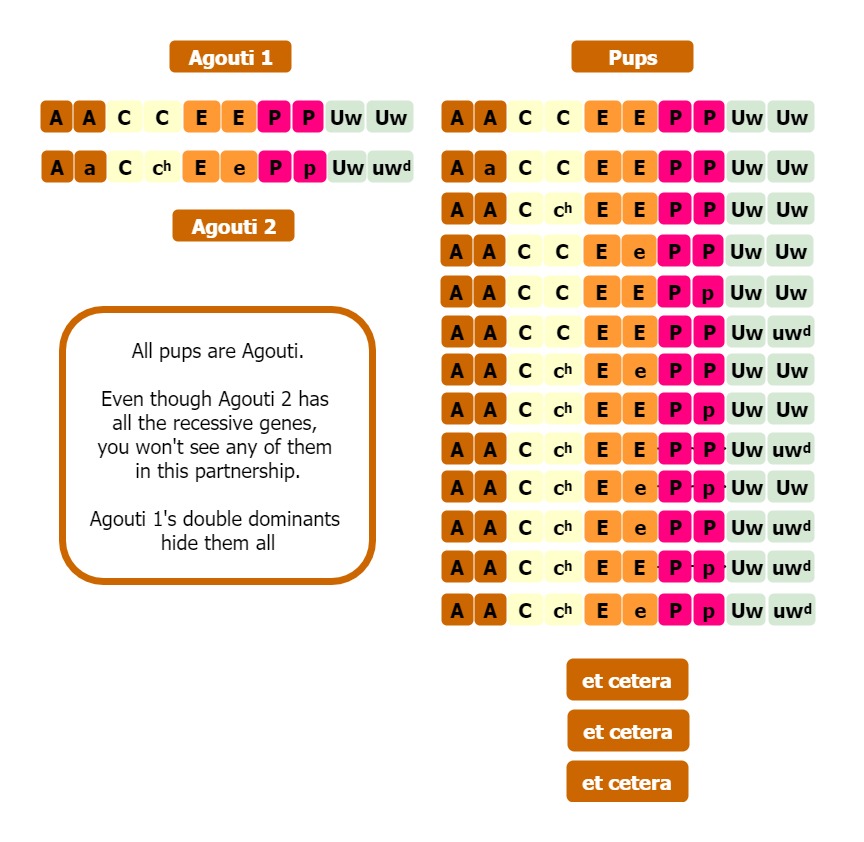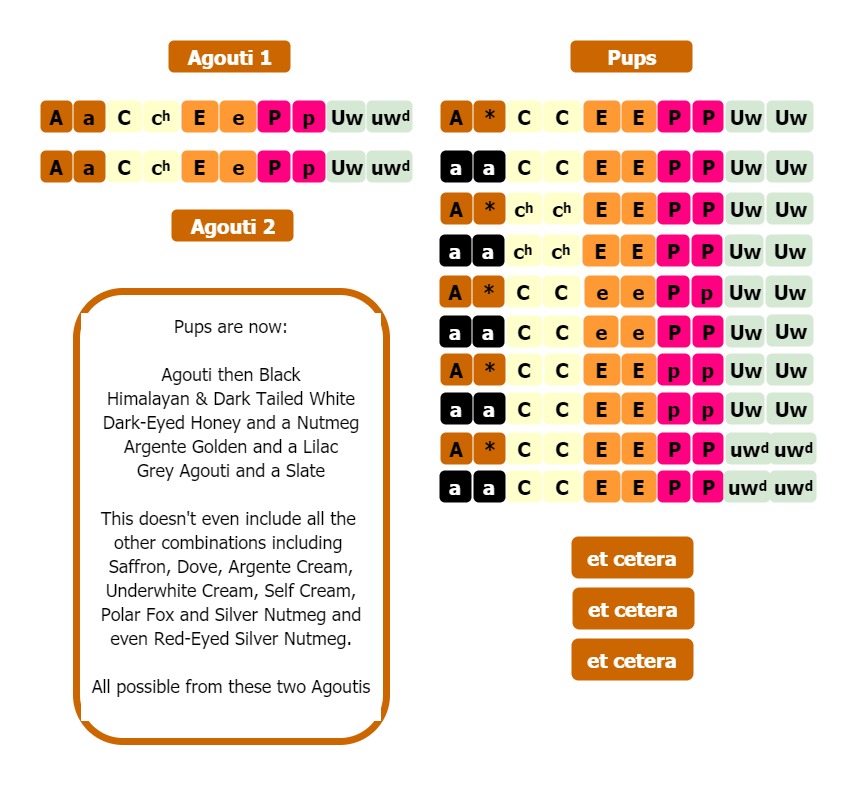Welcome to the world of gerbil colour genetics – and I wish you a happy journey.
Whether it is for fun, for breeding or for showing, this information will become an essential part of your gerbil breeding world. It becomes more interesting the more you know…
Knowing the basics of how colour genes work can help you find out the colours of your own gerbils – which is fun enough in itself – but it can also work out the colours of you potential litters.
All gerbils have to have a set of colour genes that make them what they are – you may only know some of them – you may know them all – and that is part of the fun.
Gerbil Colour Genes Reminder:
Every colour known to the gerbil fancy to date (June 2017) has a pair of genes at each of the 6 spaces made available for these genes. You should know them by now as the following:
A – the agouti gene
C – the colourpoint gene
D – the dilute gene
E – the extension of yellow gene
P – the pink eye gene
Uw – the underwhite gene
It is worth noting here: G – the gray/grey gene – this used to be where the gene that made Gray Agoutis sat (the one now called uwd or uwᵈ (underwhite dilute)) – but since the discovery of the recessive uw (cream) gene it was realised that this colour gene acted in a different way to first thought and so was moved to the Uw location.
Genes and their Meaning:
Each gene is represented by a single letter (one of two or more versions available) and each gerbil needs to have two versions of each letter in their genetic notation – AA, Aa or aa for example.
Basically, EVERY coat colour in gerbils has a specific pattern of these letters – sometimes it is represented by all of the letters and other times it only takes a few. This is because many of the genes do not actually have an effect on the colour themselves – and you don’t need to share such information when just chatting with friends.
Therefore Agouti can be represented as ACDEPUw (or just ACEPUw as the dilute gene is not often shown unless that is the gene you are interested in) – you don’t need to see all the second genes as with this chain of dominant genes – the gerbil is an Agouti no matter what they are.
Similarly, a Nutmeg can actually be represented as just aaee. You don’t need to see all the other genes at all the other places as it is just these two which have been highlighted.
There is only one colour that has the two sets of recessive genes at those two locations and so we all know it is a Nutmeg without writing down everything else.
So, why all the complicated gerbil genetics?
If you only need a few letters to know what the colours are – how can this help you to choose which gerbils to breed?
Well, it doesn’t in itself – because this only help you know the colour of the parents.
Knowing the colour of your gerbil parents doesn’t automatically tell you the colours of your pups – there are too many variables. But it is a place to start – and quite essential for forward planning.
Most people get their breeding stock from a place where there is very little knowledge of the full genetic notations – so you have to work things out. It is like a puzzle with 12 pieces you need to solve. However, as explained above – you don’t always need all 12 pieces to get started.
Let’s take this Agouti we mentioned.
To have a gerbil that is coloured like an Agouti you just need the following six genes: ACDEP and Uw. Now there are supposed to be two genes at each spot to be a full notation – but we don’t know what they are yet – so we * them to hold the spaces and to tell whoever is reading this that we don’t know for sure what they are:
So our Agouti is: A* C* D* E* P* Uw*
It is still Agouti-coloured even with all the other genes unknown – it doesn’t matter what they are – this gerbil will still be an Agouti.
However, without knowing what the 6 others represent – we can only ever predict that this gerbil would have Agouti babies for sure. It may have other colour pups depending on what the hidden genes are (all the *s above) – but we can only say for SURE that they can have Agouti pups – as they definitely have all of the genes needed to make another Agouti.
And – here is what makes it fun – this gerbil could give you a litter with only Agouti pups with no other colours at all; or, it could give you almost every colour of gerbil pup available.
How, you may ask?
It’s all about the hidden genes. And the following image will show you how things can influence the pup colours you see using our Agouti gerbil and his lady friend, also an Agouti.
He has all double dominants – where he holds only dominant genes – all his pairs are homozygous (the same at each point): So AA CC EE PP and UwUw.
Her genes are quite different. She has one of each gene version at each point (heterozygous): Aa Ccʰ Ee Pp Uwuwᵈ – big little big little etc. She is still Agouti on the outside as she has at least one dominant version at each point – but she is hiding a treasure trove of opportunity with all those recessives.
But will they be exposed by this cross?

As you can see from the above – breeding is all about knowing your hidden genes – and knowing when you don’t have any recessives is equally important.
I stopped with the pup colours calculations above after just showing the workings for the one gene point – but if you wanted to see them ALL this would be a giant image. Including the above combinations shown, you still have to work out all the combinations for the ee, pp and uw genes – and then double that all over again for when they are Aa not AA. I’m not doing it – it will take ages…
There are SO MANY different combinations of genes that could have created different colours – but instead – due to the laws of dominance – they are all Agouti.
This pair will ALWAYS have 100% Agouti pups.
Even if our Agouti male’s partner had been homozygous recessive at ALL points – so: aa cʰᵐcʰ ee pp uwᵈuwᵈ (a PEW) – the result would have been the same – 100% Agouti pups.
Agouti Pup 1: Aa Ccʰᵐ Ee Pp Uwuwᵈ
Agouti Pup 2: Aa Ccʰᵐ Ee Pp Uwuwᵈ
Agouti Pup 3: Aa Ccʰᵐ Ee Pp Uwuwᵈ
Pups can only get their genes from their parents – so this lot only have one choice. Their gene from the Dad will always be the dominant version (as that is all he has) and the gene from their mum will always be the recessive version (as that is all SHE has).
However, if they were both heterozygous – there would have been an explosion of colour as all the double recessives were pulled out into view…

If you want to plan your litters for whatever reason – you need to do your research.
Knowing your gerbil family tree can help for starters as it may stop you pairing up and breeding two gerbils whose genes are not conducive to what you want – or what is useful for the gerbils. Swapping them around in split tanks all the time; breeding females over and over and homing all the pups needs a fair bit of planning. Not things to be taken on lightly.
Learning their genes becomes easier after their first few litters as you can start to see their hidden genes cropping up in new colours – but it is only after you have seen them in action that you can start to fill in those * properly. And if you are test breeding a male or female – you would need to pair them up with the right gerbil otherwise your results won’t give you any decent results.
What does this mean for your breeding?
Understanding basic colour genetics can help to focus your litters. This means you can create whole litters of exactly the same colour – perfect for showing and colour improvement.
The same knowledge can help you create mixed or ‘rainbow litters’ where you have the genes for a wide variety of colours – where you can get something different every time.
As an added result of the latter it means that if it is a hobby – you are able to breed gerbils for longer as you are always able to find homes for your colourful youngsters. If they are all one colour – you may find yourself in a situation where you ending up having to keep all the pups yourself and soon enough find yourself with a house full of tanks a few months down the line.
Therefore learning the basics is perfect for making sure you get the gerbils you want and your gerbils are able to find loving homes while they are still young.
Good Luck!
Breeding what I call Orange in color gerbils together, will the babies be Orange in color like the parents?
Hello Shelley.
Well, it depends what ‘orange’ they are in the first place (and what their parents were) as there are three ‘main types’ of orange gerbils, but generally if both parents are the same orange color – yes, you should get at around half orange pups per litter. This increase in chances if the siblings of your oranges were also oranges too, but it depends how far back you know your family tree?
If they are both Saffron (aappee) then it is very likely that they will breed true or a very high percentage
If they are both Argente (A*pp) then you will certainly get Argente pups, but several other colours could be hiding in there
If they are both Honeys (A*ppee or A*ee) then most likely yes, but there can be hidden genes here too.
If you mix up the different oranges you will slightly increase the chances of other colours coming in through the lines – but there are easy ways to help reduce other coulours if you wanted to focus down this line over time to be only oranges?
We are more than happy to help you out with a color plan if you want – just let us know and we can message you seperately.
Good luck either way,
RodentZone